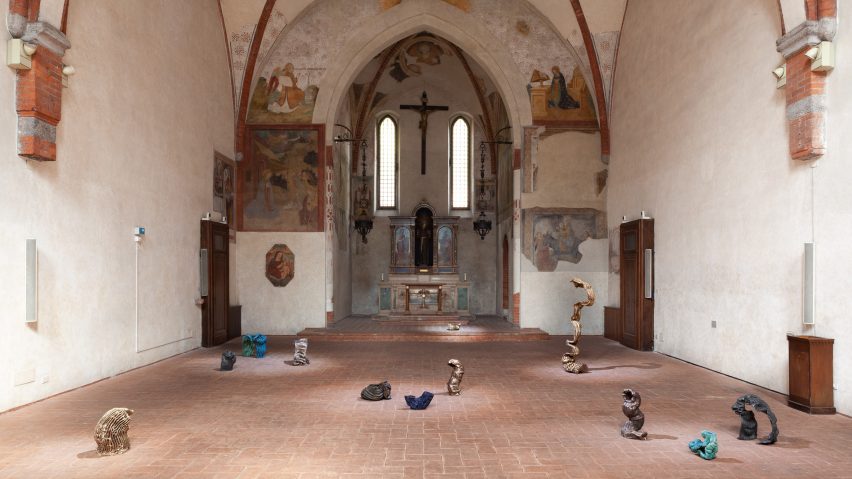Swedish-Chilean designer Anton Alvarez has brought the lost-wax casting technique into the modern age to create a series of 12 extruded bronze objects inspired by the Renaissance.
The 12 objects were featured in an exhibition curated by gallerist Nicolas Bellavance-Lecompte as part of this year's Milan design week, where they were positioned across the floor of a 15th-century Catholic church.
Called L'Ultima Cera in Italian, which translates as "The Last Wax", the exhibition is a play on both the idea of lost-wax casting, and Leonardo da Vinci's 15th-century painting The Last Supper.
"The artistic practise of Alvarez is difficult to define," said the curator. "Sitting between functional object and sculpture, his work oscillates between expression and constraint, advancing technological innovation and using traditional craftsmanship. In his objects the primordial and the futuristic meet."
The sculptures are made by pushing wax through an extrusion machine that Alvarez built himself, called The Extruder, comprised of a large metal cylinder that hangs from the ceiling by chains.
Bellavance-Lecompte describes the contraption as being "like a big pasta machine".
The Extruder uses an electric motor to exert more than six thousand pounds of pressure on the wax as it pushes it through different moulds to create an array of fluted shapes.
Underneath the machine is a pool of cold water which the extruded wax flows into. Alvarez guides the wax and tweaks it into its final form before casting the pieces in bronze.
"It's a bit like a water-birthing process," the curator told Dezeen.
In a similar fashion to the traditional lost-wax casting process, Alvarez places the wax moulds into a cocoon-like case before pouring molten bronze into a hole at the top. The bronze takes the same form as the wax shapes, which evaporate from the heat to leave a replica in bronze.
The resulting forms are functional as well as decorative, doubling up as stools, vessels, trays and a stack of shelves that can be flipped onto their side to become a bench.
While the process is fairly controlled, the results are unexpected, granting each of the 12 objects their own "personalities".
The sculptures are then coated with various chemicals such as copper oxide to encourage different patinas to form, giving each piece a unique colouring.
According to Bellavance-Lecompte, these patinas make the objects appear as if they have been retrieved from the bottom of the ocean, like "marine creatures" with architectural qualities reminiscent of Renaissance sculptures.
This is the third year Bellavance-Lecompte has curated an exhibition dedicated to contemporary collective design for 5vie – an exhibition that takes place each year during Milan design week.
Last year's exhibition also included the work of Alvarez, as he displayed a series of extruded clay vessels coloured in the vibrant blue tone favoured by artist Yves Klein.

